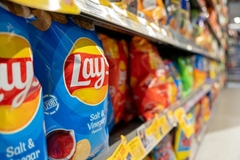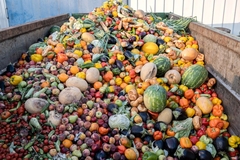California Natural Color on replacing synthetic dyes with plant-based alternatives
Key takeaways
- California Natural Color offers plant-based liquid and crystal colors similar in stability and performance to synthetic dyes.
- Red Dye No. 3 has historically been widely used for vibrant pink shades, but replacing it is technically complex due to color stability and processing challenges.
- The company supports manufacturers by offering regulatory guidance and reformulation strategies ahead of the US FDA’s Red Dye 3 ban.
California Natural Color is offering F&B manufacturers a “pathway to clean label formulations” while helping maintain the visual appeal and quality of their products, as tightening regulations push the industry away from synthetic dyes. The company’s plant-based liquid and crystal colors — made from fruits, vegetables, and other botanicals — are designed to deliver the vibrancy and stability needed to replace artificial colors without affecting product quality.
Red Dye No. 3, or FD&C Red No. 3, gives frostings, sprinkles, cake mixes, and baked goods a vibrant pink hue. Eliminating the widely used color requires a careful reformulation process.
A simple swap or 1:1 replacement will not help manufacturers overcome challenges like maintaining color vibrancy and stability during processing, says the color supplier, which launched a carrot-based alternative to caramel coloring in June.
Regulatory actions, such as the FDA’s upcoming ban on Red Dye No. 3, come after decades of debate and concerns about cancer. California’s pioneering ban, effective January 1, 2027, and West Virginia’s recent ban on food dyes in the school nutrition program, further underscore the urgency of exploring alternatives to synthetic dyes.

Despite the US’s efforts to slash artificial color usage, a gap exists between consumer expectations and the launch of clean label products. Petroleum‑based, synthetic food dyes are still present in almost half of new F&B product launches, Innova Market Insights data suggests.
Food Ingredients First speaks with Jay Howard, color technology manager at California Natural Color, to understand the technical and regulatory complexities manufacturers need to overcome to support the natural color transition by leveraging the “inherent properties of nature’s palette.”
What are the biggest challenges the F&B industry faces while transitioning to natural colors?
Howard: A challenge we frequently see when transitioning to natural colors is that many brands are accustomed to the simplicity and predictability of synthetic dyes and how they perform. Natural colors, by contrast, are not a one-size-fits-all solution. Performance depends on application-specific variables, including pH, processing conditions, heat exposure, water activity, packaging type, and ingredient interactions.
This means that selecting the natural color system (or source of color) requires thoughtful consideration. What works well in a low-pH beverage may not be best suited for a baked application — a shade that is vibrant and stable in a gummy may shift during extrusion or high-temperature processing. For manufacturers new to natural colors, understanding these nuances is an important part of the transition.
From a technical standpoint, what makes natural colors harder to stabilize or match compared to artificial ones?
Howard: Natural colors present unique challenges compared to artificial ones because they originate from diverse botanical sources with complex pigment chemistries that respond differently to factors such as pH, heat, light, and oxygen. This variability makes achieving consistent shades more demanding than with synthetics, which are engineered for uniformity. Optimizing natural color performance requires precise control over extraction, formulation, and application to ensure reliable results throughout food processing and storage.
When replacing Red Dye 3, certain categories, like baked applications, can pose greater technical hurdles, as they typically require high heat tolerance.
 Consistent natural color performance is harder than with synthetics and demands precise control from extraction to application, says Howard.
Consistent natural color performance is harder than with synthetics and demands precise control from extraction to application, says Howard.
How does California Natural Color’s crystal color technology overcome issues like heat stability, pH sensitivity, or color fading?
Howard: California Natural Color’s crystal color technology tackles these challenges by converting a highly variable raw material extract into a purified and concentrated crystal form. This innovative drying process ensures consistent color expression from batch to batch and enables very low use rates in products — typically around 0.02% or less.
Crystals are easy to implement in production, thanks to their excellent flowability, low dusting, and rapid solubility, making them practical for diverse formulations. To maximize performance, our applications team works closely with manufacturers to recommend the most suitable crystal products for specific food applications.
What regulatory or labeling challenges do manufacturers face when transitioning to natural colors?
Howard: When transitioning to natural color systems, manufacturers may face a complex regulatory landscape that varies across global markets. Natural colors can often be subject to region-specific approvals and standards, and labeling requirements. For example, ingredient declarations, usage limits, or labeling language can vary by market as they are governed by different regional standards (i.e., the EU maintains a distinct list of approved coloring foods and additives with specific criteria).
Additionally, challenges may arise when color sources lack global regulatory alignment. For example, butterfly pea flower extract is approved for use as a color additive in the US but is not yet authorized in the EU. Similarly, natural color sources may be approved only for a specific set of applications. These are just a few examples of the barriers and complexities associated with compliance and formulation across various markets.
How is California Natural Color helping manufacturers navigate the FDA’s nationwide ban on Red Dye No. 3 and similar state-level restrictions?
Howard: California Natural Color is working closely with manufacturers to help them navigate the FDA’s ban on Red 3 and other state-level restrictions by combining regulatory guidance, reformulation strategies, and hands-on technical support for tailored solutions. This includes product assessments, color matching formulation support, and collaborative workshops to help developers evaluate natural alternatives and optimize performance.
Collaborating with the right partner is essential. With the right technical support, careful evaluation of application requirements, and formulation work, brands can successfully replace synthetic dyes with natural colors that deliver on clean label and consumer expectations.
 California Natural Color’s crystal color replacements for Red Dye No. 3 offer benefits like zero calories, high concentration, and an extended 2–5 year shelf life (Image credit: California Natural Color).
California Natural Color’s crystal color replacements for Red Dye No. 3 offer benefits like zero calories, high concentration, and an extended 2–5 year shelf life (Image credit: California Natural Color).













